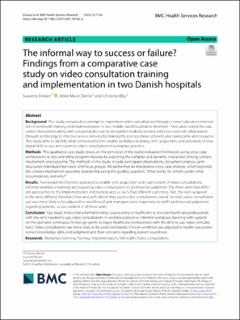| dc.description.abstract | Background
This study evaluated an attempt to implement video consultations through a novel education intervention in telehealth training and implementation in two middle-sized hospitals in Denmark. Three units tested the education intervention along with a regional decision to strengthen multidisciplinary and cross-sectoral collaboration through technology to improve service delivery by making the process more coherent and saving time and resources. This study aims to identify what contextual factors enable workplace learning, skills acquisition, and utilization of new digital skills to use and routinize video consultations in workplace practice.
Methods
This qualitative case study draws on the principles of the realist evaluation framework using cross-case comparisons to test and refine program theories by exploring the complex and dynamic interaction among context, mechanism, and outcome. The methods in this study include participant observations, document analysis, semi-structured individual interviews, and focus groups. We performed an interpretive cross-case analysis, which explored the context-mechanism-outcome relationship using the guiding question, “What works, for whom, under what circumstances, and why?”.
Results
Two broad mechanisms appeared to enable skills acquisition and routinization of video consultations: informal workplace learning and adjusting video consultations to professional judgment. The three units had different approaches to the implementation and training and, as such, had different outcomes. First, the skills acquired in the units differed; therefore, how and with whom they used video consultations varied. Second, video consultation use was more likely to be adjusted to workflows if unit managers were responsive to staff’s professional judgments regarding patients, as was evident in all three units.
Conclusion
Our study shows that a formal training course alone is insufficient to provide healthcare professionals with the skills needed to use video consultations in workplace practice. Informal workplace learning with support on the spot and continuous follow-up seems to equip healthcare professionals with the skills to use video consultations. Video consultations are more likely to be used confidently if novel workflows are adjusted to health care professionals' knowledge, skills, and judgment and their concerns regarding patient soundness. | en_US |

